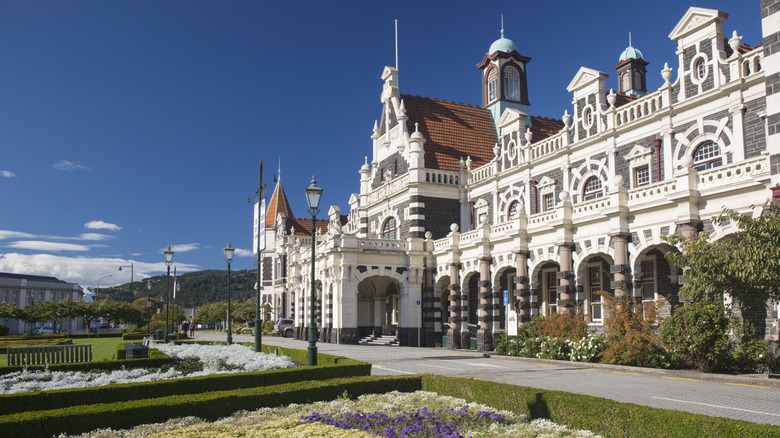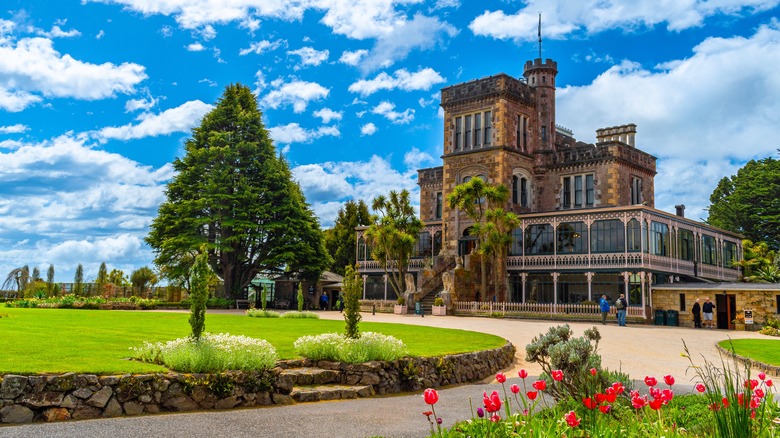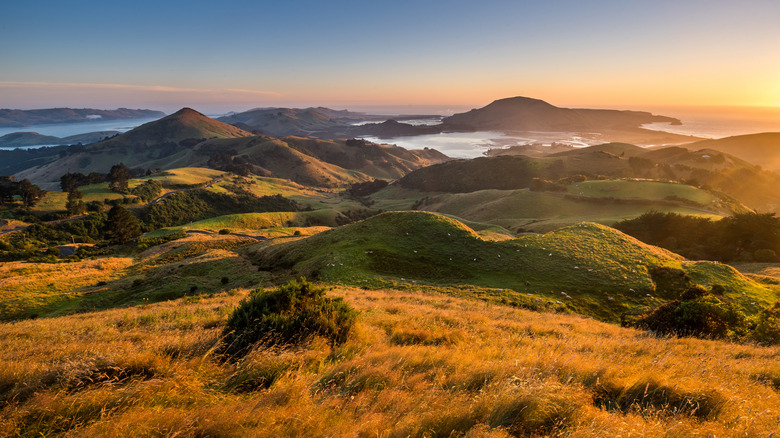The Second-Largest City On New Zealand's South Island Is Called The 'Edinburgh Of The South'
On the southeastern coast of New Zealand is a little slice of Scotland. Dunedin, the second largest city on the South Island, is the Gaelic word for Edinburgh, meaning "castle rock," a name that makes this city inextricably linked to far away Scotland through history and custom. First settled by the Scots in 1848, Dunedin has clung to its Scottish roots, proudly respecting many of the traditions practiced on the British Isle, as well as naming several streets after its namesake, with roads named Scotland Street, Highland Avenue, Aberdeen Street, Loch Lomond, Lake Highlander. Dunedin is also home to the steepest street in the world — Baldwin Street.
You can fly from Auckland to Dunedin in about two hours, but the city is also connected to other destinations around New Zealand and Australia's Gold Coast. Funnily enough, the weather in Dunedin is somewhat chilly, just like Scotland, and you'll find other traces of Dunedin's Scottish roots all over the city, with stone buildings, local bagpipers, and Scotch whisky on offer around the town.
Known by locals as the wildlife capital of New Zealand thanks to its population of wild penguins, fur seals, and native birds, Dunedin is also a great place for animal lovers and eco-tourists. A city that blends Scottish and Maori influences, Dunedin is surrounded by rolling hills and sits at the end of a harbor, Port Otago, embodying the perfect combination of Indigenous and international heritage and beautiful natural scenery.
Castles and cliffs
The official history of Dunedin dates back to the 1800s when two Scottish merchants, John O. Douglas and James Somerville petitioned the local New Zealand government to name the city after their beloved hometown in 1885. History actually points to the town having been occupied by Maori as far back as A.D. 1100, prior to the arrival of the British settlers, meaning its fascinating history extends far beyond the Victorian Era. The Otago province saw a boom in the 19th century, due to the gold rush of the late 1800s, causing migration in Dunedin to increase significantly. This, in turn, saw the construction of many Edwardian and Victorian buildings, including the iconic Railway Station, built in the classical Edwardian Baroque style of the era.
This Kiwi-Scottish pride extends to Larnach Castle, which sits on the hill of the Otago Peninsula. A gothic revival architectural feat constructed in the 1870s, Larnach is said to be haunted(and it's a hotel if you're looking for a good scare). Ghosts aside, the castle has a cafe and garden where you can have high tea and enjoy the incredible view of the local landscape of Dunedin, which may also give you chills. Lovers Leap, an observation point on the Otago Peninsula, just outside of the city center, is another place to catch the spectacular vistas on offer. This large sea arch and The Chasm cliffs around it offer an incredible way to survey the Dunedin coastline, which is replete with white sand beaches, clear skies, and dramatic cliff faces.
A highland in Australasia
The Otago Settler's Museum is a great place to discover the city's unique history. With a vast collection of artifacts and original photographs from the beginnings of Dunedin, there is also a permanent exhibition charting the origins of the Scottish Presbyterian settlement in Otago, including model replicas of the original Scottish establishments. Other notable Dunedin historical landmarks are St Paul's Cathedral, the Dunedin Law Courts, and Dunedin Gaol (Dunedin Prison Museum), the only remaining Victorian era prison in the continent, which now offers tours.
The Dunedin Scottish Arts Foundation was setup in 1967 with the aim of preserving the city's Scottish heritage through performing arts. As part of their initiative they run an annual Celtic Music and Craft Beer Festival in November as well as bagpipe programs and a Highland games festival in April. Don't leave Dunedin without stopping for a pint at Albar, a Scottish pub with a large selection of Scotch whisky, including a "Malt of the Month" and its own branded salted caramel whisky. They also have a Scottish-influenced menu that includes haggis and oatcakes, and every Tuesday around 8 p.m. a Celtic band performs live music, remiding locals to the city's Scottish roots. In fact, with so many similarities to underrated towns with rich history in Scotland, you might have trouble deciphering what continent you're on!


